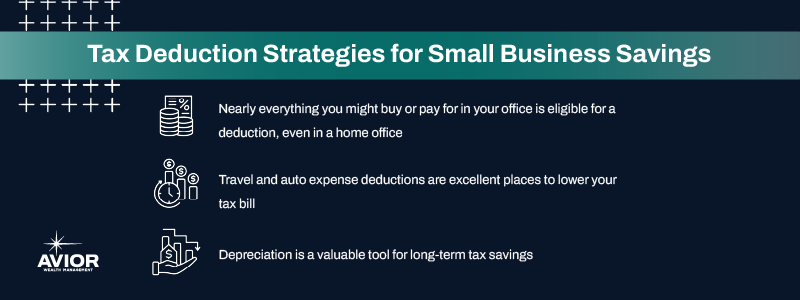Tax Deduction Strategies for Small Business Savings
Your business may qualify for many different tax deductions. You just need to know where to look.

Small business owners face complex options when trying to navigate tax deductions. In fact, 37% experience feelings of anxiety and confusion on this topic.
It’s easy to get frustrated with the process and give up altogether, but then you risk losing a crucial opportunity to find significant savings. A wide range of tax deductions are readily available when you prioritize time and planning.
Below, we walk through the top deduction strategies that can help small businesses, including tips and insights to optimize the process and clear the way for improved financial health.
Top three tax deductions for small businesses
From advertising to bank fees to power lunches, it can all add up to significant savings. But which deductions are relevant to your company? Here are three options to consider:
- Office rent. If you rent your office space and/or equipment, those rental payments are a deductible business expense. This does not apply if you work out of a home office – there is a separate set of deductions for that.
- Salaries and benefits. Your employees’ salaries, benefits, and vacation time are tax-deductible, provided that an employee is not the sole proprietor, a partner, or a member of an LLC; their salary is reasonable; and they actually provided the services their job requires.
- Advertising and promotion. Promotion and advertising are completely deductible. This includes printing promotional materials, paying a designer to craft a logo, designing and launching a website, running an event, and putting up a paid social media campaign.
Consider the example of Saskia, a single, self-employed graphic designer with no children. In 2023, she brought in $60,000 in self-employment income and owes 15.3% in self-employment tax ($8,478), plus $4,865 in income tax, totaling $13,343.
But, with the help of a financial planner, she discovered $6,000 in advertising expenses she forgot to record. These deductions came out of her net self-employment income, bringing it down to $54,000. She now has a lower tax burden of $7,630 in self-employment tax and $4,200 in income tax for a new total of $11,830.
Home office deductions
If you work at home, you may be able to deduct some of your housing costs. There are two ways to do it:
- Standard method. Track all actual expenses that come with home maintenance, including rent, mortgage interest, utilities, HOA fees, real estate taxes, repairs, landscaping, and housekeeping. Multiply the total by the percentage of your home that you use for your business.
- Simplified method. If the first method sounds a bit too complicated, simply deduct $5 per square foot of your home that you actively use for your business. This is valid for up to 300 square feet.
To qualify for this deduction, you’ll need to meet two criteria:
- First, you must pass the regular and exclusive use requirements, which means you use a home office solely for business purposes, and it has a clear boundary separate from the rest of the house. Second, your home office needs to be your principal place of business.
If you calculate using the standard method, you will have to file Form 8829 as well as Schedule C.
Auto expense deductions
If you use your car exclusively for business, you can deduct the total cost of what it takes to operate the vehicle. If you take the kids to school and take deliveries to clients, then you need to separate personal costs from professional costs and deduct only the latter.
There are two ways to deduct business vehicle expenses:
- Standard mileage rate. With the standard mileage rate, you can claim the business vehicle tax deduction for every mile driven in service of the business. In 2024, that’s 67 cents per mile, up from 65.5 cents in 2023. If you spend a lot of time in the car for work, this deduction can add up fast – driving 8,000 miles this year would yield a deduction of $5,360 (8,000 x $0.67). This method is required for your first year using the car professionally. After that, you can choose which approach works best for you.
- Actual expense method. With this method, you can claim a percentage of the total cost of the car by simply tracking your payments during the year. You can deduct additional expenses including repairs and maintenance, gas and oil, auto insurance, registration fees and licenses, and tire repair or replacement.
No matter which method you choose, tracking the business miles you drive is key, whether it’s via an app, spreadsheet, or a notebook you keep in the car. It’s important to note that you can’t deduct miles spent driving to and from work – those are personal commuting expenses.
Travel expense deductions
Any deducted business travel must be necessary and away from your tax home for longer than a normal work day, and you must rest or sleep somewhere along the way. There are many forms of deductible travel expenses:
- Travel by car, train, or plane
- Car rental and miles, parking, and tolls
- Taxis, rideshares, or public transit
- Meals, lodging, and tips
- Laundry and dry cleaning
- Shipping of samples, display materials, or other business-related items
As always, it’s crucial to document any and all travel expenses, including reasons for travel, dates of departure/return, mileage, and who you interacted with.
Equipment and supplies deductions
If you have purchased equipment, you may qualify for the Section 179 deduction. This immediate deduction applies to a select group of items including office equipment, business machinery, computers, and vehicles. The equipment needs to be put to use in that tax year. You can deduct up to $1,080,000 per year. If your company bought a piece of machinery for $50,000 and used it only for business, you could write it off entirely that same year, rather than depreciate it for $10,000 a year over five years.
There are several other key equipment deduction options to consider:
- Standard depreciation. This spreads deductions for the cost of equipment over several years, which vary depending on the type of item.
- De minimis safe harbor election. This allows for deductions of assets that cost less than $2,500 each.
- Bonus depreciation. This is less flexible than Section 179 rules but has no dollar limit attached to it.
New equipment can boost efficiency, improve morale, and qualify your business for significant tax breaks. Don’t hesitate to talk with your tax advisor to work out what’s best for you and your company.
Maximize business deductions with Avior
Tax deductions help you lower your annual tax bill and give you additional resources to grow and thrive. From office furniture to company cars to salaries, there are a plethora of deductions available in just about every aspect of your business.
It’s imperative to stay on top of the latest tax deduction developments, or risk leaving money on the table. When in doubt, always consult a tax professional. The team at Avior Wealth Management has decades of tax expertise to help ensure you and your organization can plan for a robust and exciting future.
Ready to get started? Reach out today for a one-on-one consultation.
Disclaimer: Nothing contained herein should be construed as legal or tax advice. Avior and our Advisors will work with your attorney and/or tax professional to assist with your legal and tax strategies. Please consult your attorney or tax professional with specific legal and/or tax questions. Investment Management and Financial Planner are offered through Avior Wealth Management, LLC, an SEC-registered investment advisor. Past performance is not a guarantee of future results. Investments are subject to loss, including the loss of principal.
No Comments
Sorry, the comment form is closed at this time.




